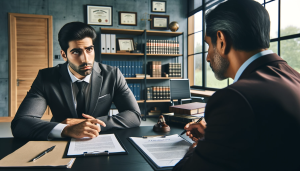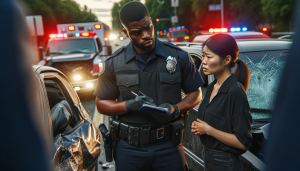Introduction
Being involved in a
car accident can be a stressful experience, and when the vehicle isn’t even yours, it adds an extra layer of complexity. This scenario brings up several important questions: Who is liable—the driver, the car owner, or perhaps both? How does insurance work in such situations? And what legal responsibilities do each party hold? Understanding the dynamics of accidents in borrowed vehicles is crucial whether you are the one lending your car or the one behind the wheel. Misunderstanding your responsibilities could lead to costly legal complications and unexpected financial burdens.
In this article, we will cover the key considerations for anyone involved in an accident while driving or lending a borrowed vehicle. From determining liability to navigating insurance claims, we’ll clarify the legal and financial aspects to help you better protect yourself. Let’s break down what happens in the event of an accident in a borrowed car and the steps you should take to handle it effectively.
Understanding Liability in a Borrowed Car Accident
What Is a Borrowed Car?
A borrowed car is simply a vehicle owned by one person and driven by another individual with permission. This could involve borrowing a family member’s car for a few days, using a friend’s vehicle to run an errand, or even driving a co-worker’s car to a work-related event. The key factor here is consent: if the vehicle is driven without the owner’s permission, the legal implications can change significantly.

Who Is Liable: The Driver or the Owner?
In most borrowed
car accident cases, liability generally follows the car, not the driver. This means that, in many scenarios, the car owner’s insurance is considered the primary coverage. However, depending on the specifics of the accident and the insurance policy, the driver’s own insurance (if they have it) could be used as secondary coverage to cover any damages that exceed the owner’s policy limits.
Several scenarios can determine liability in borrowed
car accidents:
- Permissive Use: The driver has explicit permission from the owner to use the vehicle, and the owner’s insurance generally covers the damages resulting from an accident. However, certain policies may limit coverage if the vehicle was used for specific purposes outside the owner's consent.
- Non-Permissive Use: If the driver took the car without permission, the car owner may not be held liable, and the driver could face criminal charges, depending on the circumstances. The owner’s insurance may deny any claims, leaving the driver fully responsible for all damages.
- Business or Commercial Use: If the car was being used for business purposes, the owner’s personal auto insurance may not apply. Instead, commercial insurance might be required, which can significantly alter who is liable and how claims are handled.
Insurance Coverage for Borrowed Cars
How Does Auto Insurance Work in Borrowed Car Scenarios?
When you’re driving a borrowed car, the owner’s auto insurance is typically considered the primary coverage. This means that if you get into an accident, the owner’s insurance policy is the first to cover any damages or injuries, up to its policy limits. If the damages exceed the limits of the primary insurance, your own personal auto insurance (if applicable) may be tapped as secondary coverage. This scenario is more likely if the accident results in significant injuries or property damage.
Primary vs. Secondary Insurance Coverage
- Primary Insurance: The car owner’s insurance policy is considered primary and pays out first, covering costs related to bodily injuries, property damage, and other liabilities up to the policy’s limits.
- Secondary Insurance: The driver’s insurance (if they have their own policy) serves as a backup, kicking in when the primary coverage isn’t sufficient to cover all damages. If neither party has sufficient insurance, both could face out-of-pocket expenses.
What If Neither the Driver Nor the Owner Has Insurance?
Driving a car without insurance is illegal in most states and could lead to severe penalties, such as heavy fines, license suspension, or even jail time. If neither party has insurance, both the owner and the driver could be held personally responsible for damages and injuries. In such cases, consulting a legal professional immediately is essential to protect yourself from further legal and financial liabilities.
Legal Implications for the Car Owner
Does the Owner Always Bear Responsibility?
Not necessarily. The car owner’s responsibility depends on factors such as whether the driver had permission to use the vehicle, whether the driver has insurance, and the details of the accident itself. Even when the owner’s insurance is the primary coverage, the circumstances of the accident may limit the owner’s liability.
Vicarious Liability Explained
Vicarious liability occurs when a car owner is indirectly responsible for another person’s actions while driving their vehicle. This is typically seen when a minor, a household member, or an employee uses the car. For example, if a parent allows their teenager to drive the family car and the teenager causes an accident, the parent could be held vicariously liable for any resulting damages or injuries.
Protecting Yourself as a Car Owner
To minimize risks, car owners should:
- Make sure their insurance policy is up-to-date and provides adequate coverage.
- Limit who has access to their vehicle.
- Consider adding an umbrella policy for additional liability protection.
- Understand how their policy defines permissive use and exclusions for business or non-permissive usage.
Legal Responsibilities for the Borrower (Driver)
Understanding Your Legal Rights
As a driver, you might assume that you’re always covered by the car owner’s insurance, but that’s not always the case. If the car owner’s policy has limitations or exclusions, you could be left responsible for damages, especially if you’re using the vehicle for a purpose not approved by the owner. Always check with the car owner and, if possible, review the insurance policy to understand the extent of coverage before getting behind the wheel.
Potential Legal Penalties
If you are found at fault in a borrowed
car accident, you may be held liable for the damages, even if you believed you were covered by the owner’s insurance. If your insurance doesn’t cover the full amount, you may face out-of-pocket expenses, legal fees, or even civil lawsuits from other parties involved.
What to Do Immediately After an Accident?
If you’re involved in an accident while driving a borrowed car, follow these steps:
- Prioritize Safety: Check for injuries and, if needed, call emergency services.
- Exchange Information: Gather the other driver’s contact and insurance information. Also, document your own and the car owner’s details.
- Document the Scene: Take photos of the accident scene, vehicle damage, and any relevant road conditions.
- Contact the Car Owner: Notify the car owner as soon as possible and share details about the accident.
- Report to Insurance Companies: Both the owner and driver should inform their respective insurance companies about the accident.
- Consult a Legal Professional: If the liability or coverage situation is unclear, consult an attorney to protect your rights and avoid potential pitfalls.
Steps to Take Immediately After an Accident in a Borrowed Car
Getting into an accident is never a pleasant experience, and when it involves a borrowed vehicle, it can feel even more overwhelming. However, by taking the right steps immediately following the incident, you can protect your interests, comply with legal requirements, and make the insurance claim process smoother. Here’s a detailed breakdown of what you should do if you find yourself in this situation.
1. Safety First – Ensuring Everyone’s Well-being
The first priority after any accident is ensuring the safety of everyone involved. Check yourself and your passengers for injuries, then check the occupants of the other vehicle(s). If anyone is hurt, call emergency services right away. Even if injuries seem minor, it’s better to err on the side of caution and get medical help. Moving injured persons should only be done if absolutely necessary (e.g., if there’s a risk of fire or another collision).
Once you’ve confirmed everyone’s safety, and if the vehicles are still drivable, move them out of the way of traffic to avoid causing further accidents. Turn on your hazard lights to alert other drivers and set up warning triangles if you have them.
2. Gather Evidence and Document the Scene
After ensuring safety, it’s time to document the accident scene. Thorough documentation can help you in insurance claims and legal proceedings later. Here’s what you should focus on:
- Take Photos and Videos: Use your phone to take pictures from multiple angles. Capture the damage to all vehicles involved, the positions of the cars, any skid marks on the road, and surrounding traffic signs or signals. Don’t forget to include the inside of the car to document any deployed airbags or interior damage.
- Get Witness Information: If there are any bystanders who saw the accident happen, ask for their contact information. A neutral witness’s account can be valuable in determining fault.
- Exchange Information: Collect the contact details, driver’s license numbers, and insurance information of all drivers involved. If possible, get a photo of their driver’s license and insurance card.
- Write Down What Happened: While it’s still fresh in your mind, jot down a brief description of the events leading up to the accident. Include details such as the speed you were traveling, weather conditions, road conditions, and what actions you took to avoid the collision.

3. Contacting the Insurance Companies and Authorities
Once you’ve gathered information at the scene, the next step is to notify the appropriate parties. Here’s who to contact and why:
- Call the Police: In most states, it’s legally required to call the police if there are injuries or significant property damage. Even if it’s not mandatory, it’s still a good idea to file a police report, as it serves as an official record of the incident. The report can also help establish liability and provide details that might be crucial for your insurance claim.
- Inform Both Insurance Companies: You’ll need to contact both your own insurance company and the car owner’s insurance provider. Explain that you were driving a borrowed vehicle and provide all the necessary information, such as the owner’s name, insurance policy number, and the details of the accident.
4. Hiring an Attorney for Borrowed Car Accidents
If the accident involves significant damage, injuries, or disputes over liability, it’s wise to seek legal counsel. An experienced attorney can help navigate the complexities of the situation and ensure that your rights are protected.
When Should You Seek Legal Counsel?
- If the accident resulted in serious injuries or high property damage.
- If there is confusion or disagreement over who is liable.
- If the car owner’s insurance company is denying coverage.
- If you or the car owner are being sued by the other driver(s).
Finding the Right Attorney for Your Case
It’s crucial to find an attorney who specializes in
auto accident cases, specifically those involving borrowed vehicles. Look for someone with a proven track record in handling similar cases, as they will be familiar with the nuances of insurance policies and liability issues.
Key Questions to Ask a Personal Injury Attorney
- What are my rights and liabilities?
- How will the insurance coverage apply in my case?
- What is the expected outcome, and what steps should I take?
5. Dealing with Uninsured or Underinsured Borrowed Car Accidents
Accidents become even more complicated if the driver or car owner is uninsured or underinsured. In these cases, your options might be limited, and legal recourse may be necessary.
What Does It Mean to Be Uninsured or Underinsured?
An
uninsured driver has no car insurance at all, which is illegal in most states. An
underinsured driver has some coverage, but it’s not enough to cover the total damages resulting from the accident.
Options for the Borrower and the Car Owner
If the driver is uninsured, the car owner’s policy might still cover the damages, depending on the policy terms. However, if neither party has adequate coverage, you might need to file a claim through
uninsured/underinsured motorist coverage if it’s included in your policy. This type of coverage can help pay for damages when the at-fault driver’s insurance isn’t enough.
Legal Recourse in Such Scenarios
Consulting with an attorney is highly recommended in these cases, as they can explore other options, such as filing a
personal injury lawsuit or negotiating settlements with other involved parties.
6. Impact of Borrowed Car Accidents on Insurance Rates
Even if you were driving a borrowed car, the accident can still have repercussions for both you and the car owner when it comes to insurance rates.
Will Your Insurance Premiums Increase?
Yes, it’s possible for both the car owner’s and the driver’s insurance premiums to go up after an accident, depending on the circumstances and the insurance provider’s policies. If you’re the driver and have your own insurance, you may see an increase if your policy was used as secondary coverage.
How Does the Accident Affect the Owner’s Record?
The owner’s insurance history will reflect the accident, which may lead to higher rates in the future. This is true even if the owner wasn’t driving the car at the time of the incident.
7. Steps to Mitigate Insurance Rate Hikes
There are a few strategies that both the driver and the car owner can employ to prevent significant insurance premium increases:
- Take a Defensive Driving Course: Completing a certified defensive driving course can sometimes result in a discount on insurance premiums.
- Inquire About Accident Forgiveness Policies: Some insurance companies offer accident forgiveness programs that prevent your first at-fault accident from affecting your rates.
- Maintain a Clean Driving Record: Going forward, practice safe driving habits and avoid traffic violations to keep your record clean.
- Review Insurance Coverage Regularly: Make sure your coverage is adequate and explore other options if your current provider imposes a significant rate hike.
Conclusion
Auto accidents in borrowed cars can be legally and financially complicated. Whether you’re the owner or the borrower, understanding your rights, liabilities, and insurance coverage is essential. By taking the proper steps and seeking legal advice when necessary, you can navigate these situations more confidently.
Look for an attorney who has the right legal resources for your legal needs.
Contact us here on the
Warmuth Law website or through our hotline 888-517-9888.
Frequently Asked Questions (FAQ's)
1. Does My Auto Insurance Cover Me When I Drive Someone Else’s Car?
Yes, most insurance policies provide coverage for occasional use of another vehicle, but it depends on the specific terms and conditions.
2. What If the Borrowed Car Is Involved in a Hit-and-Run?
Report the incident immediately to the police and the insurance companies. Coverage may vary based on policy details.
3. Will the Car Owner Be Liable If They Didn’t Permit the Driver to Borrow the Car?
No, in most cases, the owner isn’t held responsible for accidents involving non-permissive use.
4. Can I Be Sued Personally for an Accident in a Borrowed Car?
Yes, if you’re at fault and insurance doesn’t cover all damages, you could be sued for the remaining amount.
What Happens If I Crash a Rented Vehicle Instead of a Borrowed Car?
Rented cars often come with their own insurance options, but your personal policy or credit card benefits may also apply.













